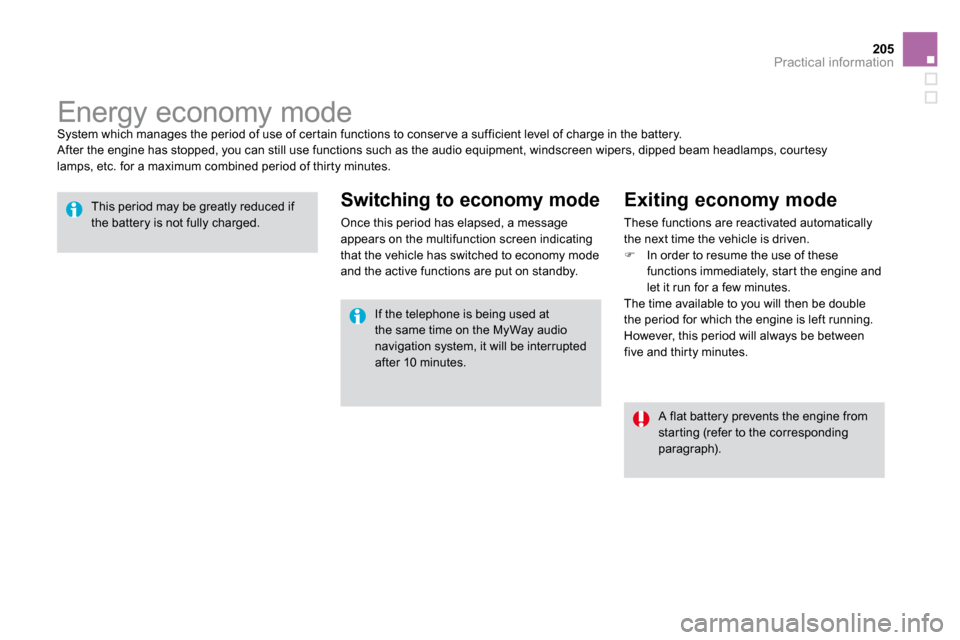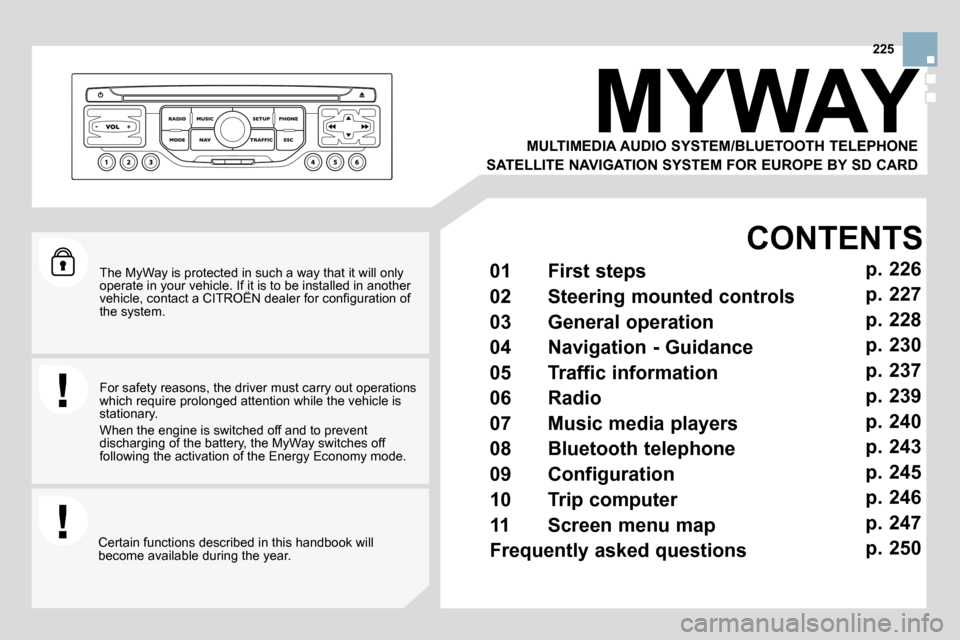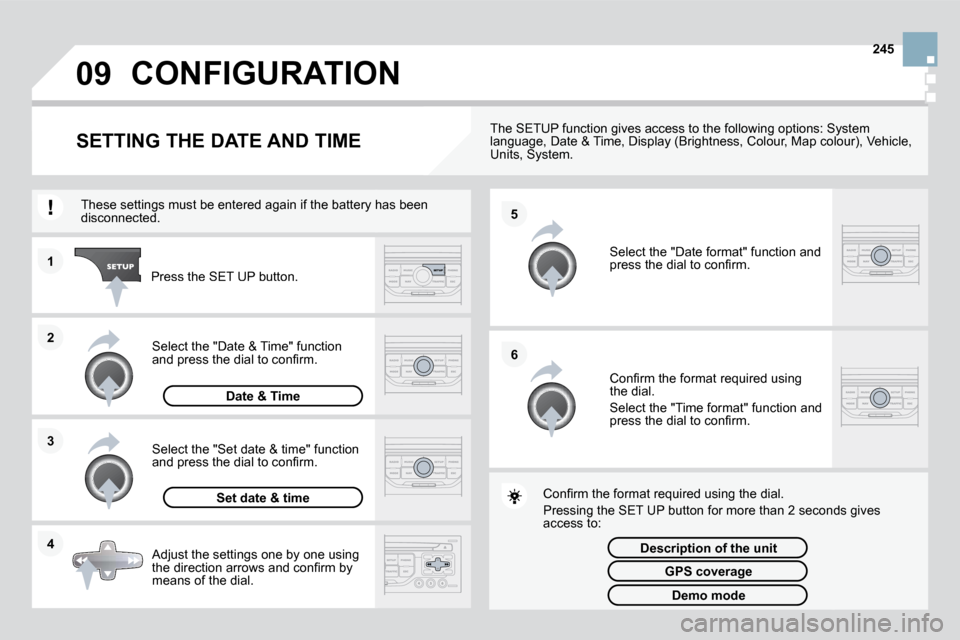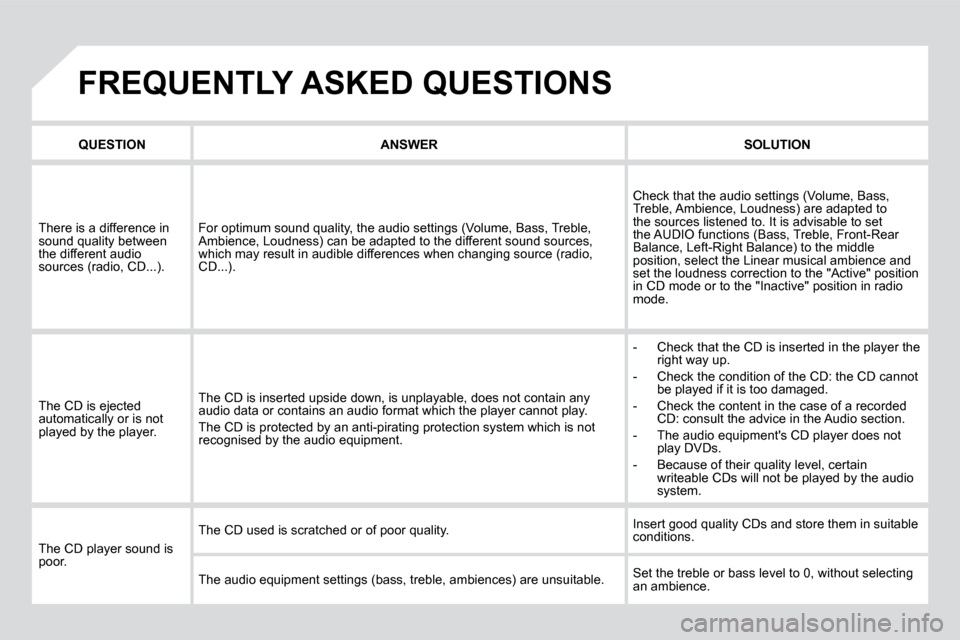ECO mode Citroen DS3 DAG 2010 1.G Owner's Guide
[x] Cancel search | Manufacturer: CITROEN, Model Year: 2010, Model line: DS3 DAG, Model: Citroen DS3 DAG 2010 1.GPages: 253, PDF Size: 7.45 MB
Page 178 of 253

Load reduction mode System which manages the use of cer tain functions according to the level of charge remaining in the battery. When the vehicle is being driven, the load reduction function temporarily deactivates cer tain functions, such as the air conditioning,
the heated rear screen... The deactivated functions are reactivated automatically as soon as conditions permit.
Do not disconnect the terminals while the engine is running. Do not charge the batteries without disconnecting the terminals first.
Before disconnecting the battery
Wait 2 minutes after switching off the ignition before disconnecting the battery. Close the windows and the doors before disconnecting the battery.
Following reconnection of the battery
Following reconnection of the battery, switch on the ignition and wait 1 minute before star ting to permit initialisation of the electronic systems. However, if minor problems persist following this operation, contact a CITROËN dealer. Referring to the corresponding section,
you should yourself reinitialise: - the remote control key, - the GPS satellite navigation system.
Page 179 of 253

205Practical information
Energy economy mode
System which manages the period of use of cer tain fu nctions to conser ve a sufficient level of charge in the battery. After the engine has stopped, you can still use func tions such as the audio equipment, windscreen wipers, dipped beam headlamps, cour tesy lamps, etc. for a maximum combined period of thir ty mi nutes.
This period may be greatly reduced if the battery is not fully charged.
A flat battery prevents the engine from star ting (refer to the corresponding paragraph).
If the telephone is being used at the same time on the MyWay audio navigation system, it will be interrupted after 10 minutes.
Switching to economy mode
Once this period has elapsed, a message
appears on the multifunction screen indicating that the vehicle has switched to economy mode and the active functions are put on standby.
Exiting economy mode
These functions are reactivated automatically
the next time the vehicle is driven. � In order to resume the use of these functions immediately, star t the engine and let it run for a few minutes. The time available to you will then be double the period for which the engine is left running. However, this period will always be between five and thir ty minutes.
Page 188 of 253

215Technical data
WEIGHTS AND TOWED LOADS (in kg)
Petrol enginesVTi 95VTi 120THP 150
GearboxesManualManualAutoManual
Model codes: SA...8FR05FS05FS95FR85FX8
- Unladen weight 1 075 1 075 1 089 1 165
- Kerb weight 1 150 1 150 1 164 1 240
- Gross vehicle weight (GV W) 1 552 1 554 1 587 1 597
- Gross train weight (GTW) on a 12 % gradient 2 452 2 454 2 487 2 497
- Braked trailer (within the GTW limit) on a 12 % gradient 900 900 900 900
- Braked trailer * (with load transfer within the GTW limit) 1 150 1 150 1 150 1 150
- Unbraked trailer 570 570 570 570
- Recommended nose weight 46 46 46 46
* The weight of the braked trailer can be increas ed, within the GTW limit, if the GV W of the towing vehicle is reduced by an equal amount. Warning: towing using a lightly loaded towing vehicle may have an adverse effect on its road holding.
The GTW and towed load values indicated are valid u p to a maximum altitude of 1 000 metres; the towed load mentioned must be reduced by 10 % for each additional 1 000 metres of altitude. The speed of a towing vehicle must not exceed 60 m ph (100 km/h) (comply with the legislation in force in your country). High ambient temperatures may result in a reduction in the per formance of the vehicle to protect the engine; if the ambient temperature is above 37 °C, limit the towed load.
Page 189 of 253

217Technical data
WEIGHTS AND TOWED LOADS (in kg)
Diesel enginesHDi 70PEFHDi 90 PEF 99gHDi 90 PEFHDi 110 PEF
GearboxManualManualManualManualManual
Model codes: SA...8HR09HP49HP09HP0/S9HR8
- Unladen weight 1 070 1 080 1 080 1 085 1 090
- Kerb weight 1 145 1 155 1 155 1 160 1 165
- Gross vehicle weight (GV W) 1 553 1 565 1 584 1 602 1 612
- Gross train weight (GTW) on a 12 % gradient 2 253 2 065 2 484 2 502 2 512
- Braked trailer (within GTW limit) on 12 % gradient 700 500 900 900 900
- Braked trailer * (with load transfer with the GTW limit) 950 500 1 150 1 150 1 150
- Unbraked trailer 570 500 570 570 570
- Recommended nose weight 46 46 46 46 46
The GTW and towed load values indicated are valid up to a maximum altitude of 1 000 metres; the towed load mentioned must be reduced by 10 % for each additional 1 000 metres of altitude. The speed of a towing vehicle must not exceed 60 m ph (100 km/h) (comply with the legislation in force in your country). High ambient temperatures may result in a reduction in the per formance of the vehicle to protect the engine; if the ambient temperature is above 37 °C, limit the towed load.
* The weight of the braked trailer can be increased, within the GTW limit, if the GV W of the towin g vehicle is reduced by an equal amount. Warning: towing using a lightly loaded towing vehicle may have an adverse effect on its road holding.
Page 193 of 253

225
The MyWay is protected in such a way that it will only operate in your vehicle. If it is to be installed in another �v�e�h�i�c�l�e�,� �c�o�n�t�a�c�t� �a� �C�I�T�R�O��N� �d�e�a�l�e�r� �f�o�r� �c�o�n�fi� �g�u�r�a�t�i�o�n� �o�f� operate in your vehicle. If it is to be installed in another operate in your vehicle. If it is to be installed in another
the system.
Certain functions described in this handbook will become available during the year.
MYWAY
For safety reasons, the driver must carry out operations which require prolonged attention while the vehicle is stationary.
When the engine is switched off and to prevent discharging of the battery, the MyWay switches off following the activation of the Energy Economy mode.
MULTIMEDIA AUDIO SYSTEM/BLUETOOTH TELEPHONE
SATELLITE NAVIGATION SYSTEM FOR EUROPE BY SD CARD
01 First steps
CONTENTS
02 Steering mounted controls
03 General operation
04 Navigation - Guidance
05 Traffic information
06 Radio
07 Music media players
08 Bluetooth telephone
09 Configuration
10 Trip computer p.
p.
p.
p.
p.
p.
p.
p.
p.
p.
11 Screen menu map
Frequently asked questions p.
p. 226
227
228
230
237
239
240
243
245
246
247
250
Page 207 of 253

06
3
2
1
1
239
SELECTING A STATION
When the current radio station is displayed on the screen, press the dial.
The radio source short-cuts menu appears and provides access to The radio source short-cuts menu appears and provides access to �t�h�e� �f�o�l�l�o�w�i�n�g� �s�h�o�r�t�-�c�u�t�s�:�
Select the function required and �p�r�e�s�s� �t�h�e� �d�i�a�l� �t�o� �c�o�n�fi� �r�m� �t�o� �g�a�i�n� access to the corresponding settings.
TA
� � �R�D�S�,� �i�f� �d�i�s�p�l�a�y�e�d�,� �a�l�l�o�w�s� �y�o�u� �t�o� �c�o�n�t�i�n�u�e� �l�i�s�t�e�n�i�n�g� �t�o� �t
�h�e� �s�a�m�e� � � �R�D�S�,� �i�f� �d�i�s�p�l�a�y�e�d�,� �a�l�l�o�w�s� �y�o�u� �t�o� �c�o�n�t�i�n�u�e� �l�i�s�t�e�n�i�n�g� �t�o� �t�h�e� �s�a�m�e� �s�t�a�t�i�o�n� �b�y� �a�u�t�o�m�a�t�i�c� �r�e�t�u�n�i�n�g� �t�o� �a�l�t�e�r�n�a�t�i�v�e� �f�r�e�q�u�e�n�c�i�e�s�.� �H�o�w �e�v�e�r�,� �s�t�a�t�i�o�n� �b�y� �a�u�t�o�m�a�t�i�c� �r�e�t�u�n�i�n�g� �t�o� �a�l�t�e�r�n�a�t�i�v�e� �f�r�e�q�u�e�n�c�i�e�s�.� �H�o�w�e�v�e�r�,� �i�n� �c�e�r�t�a�i�n� �c�o�n�d�i�t�i�o�n�s�,� �c�o�v�e�r�a�g�e� �o�f� �a�n� �R�D�S� �s�t�a�t�i�o�n� �m�a�y� �n�o�t� �b�e� �i�n� �c�e�r�t�a�i�n� �c�o�n�d�i�t�i�o�n�s�,� �c�o�v�e�r�a�g�e� �o�f� �a�n� �R�D�S� �s�t�a�t�i�o�n� �m�a�y� �n�o�t� �b�e� assured throughout the entire country as radio stations do not assured throughout the entire country as radio stations do not cover 100 % of the territory. This explains the loss of receptio n of This explains the loss of reception of the station during a journey.
�T�h�e� �e�x�t�e�r�n�a�l� �e�n�v�i�r�o�n�m�e�n�t� �(�h�i�l�l�,� �b�u�i�l�d�i�n�g�,� �t�u�n�n�e�l�,� �u�n�d�e�r�g�r�o�u�n�d� �c�a�r� �p�a�r�k�.�.�.�)� �m�a�y� �i�n�t�e�r�f�e�r�e� �w�i�t�h� �t�h�e� �r�e�c�e�p�t�i�o�n�,� �i�n�c�l�u�d�i�n�g� �i�n� �R�D�S� �f�o�l�l�o�w�i�n�g� �m�o�d�e�.� �T�h�i�s� �p�h �e�n�o�m�e�n�o�n� �i�s� �a� �n�o�r�m�a�l� �r�e�s�u�l�t� �o�f� �t�h�e� �w�a�y� �i�n� �w�h�i�c�h� radio waves are transmitted and does not in any way indicate a failure of the audio equipment.
RDS - REGIONAL MODE
� � �P�r�e�s�s� �t�h�e� �R�A�D�I�O� �b�u�t�t�o�n� �t�o� �d�i�s�p�l�a�y� the list of stations received locally sorted in alphabetical order.
Select the station required by turning �t�h�e� �d�i�a�l� �a�n�d� �p�r�e�s�s� �t�o� �c�o�n�fi� �r�m�.� �
Regional prog.
Radiotext
RDS
While listening to the radio, press one of the buttons to select the previous or next station on the list.
Press one of the buttons on the numeric keypad fo r moor more than 2 seconds to store the current station. Press the button on the numeric keypad to recall the stothe stored radio station.
AM
RADIO
A long press of one of the buttons starts the automatic search for a station with a lower or higher frequency.
Page 213 of 253

09
4
3
2
1
6
5
245
CONFIGURATION
SETTING THE DATE AND TIME � � �T�h�e� �S�E�T�U�P� �f�u�n�c�t�i�o�n� �g�i�v�e�s� �a�c�c�e�s�s� �t�o� �t�h�e� �f�o�l�l�o�w�i�n�g� �o�p�t�i�o�n�s�:� �S�y�s�t
�e�m� �l�a�n�g�u�a�g�e�,� �D�a�t�e� �&� �T�i�m�e�,� �D�i�s�p�l�a�y� �(�B�r�i�g�h�t�n�e�s�s�,� �C�o�l�o�u�r�,� �M�a�p� �c�o�l�o�u�r�)�, � �V�e�h�i�c�l�e�,� Units, System.
Adjust the settings one by one using �t�h�e� �d�i�r�e�c�t�i�o�n� �a�r�r�o�w�s� �a�n�d� �c�o�n�fi� �r�m� �b�y� means of the dial.
� � �S�e�l�e�c�t� �t�h�e� �"�D�a�t�e� �f�o�r�m�a�t�"� �f�u�n�c�t�i�o�n� �a�n�d� �p�r�e�s�s� �t�h�e� �d�i�a�l� �t�o� �c�o�n�fi� �r�m�.� �
� � �S�e�l�e�c�t� �t�h�e� �"�S�e�t� �d�a�t�e� �&� �t�i�m�e�"� �f�u�n�c�t�i�o�n� �a�n�d� �p�r�e�s�s� �t�h�e� �d�i�a�l� �t�o� �c�o�n�fi� �r�m�.�
� � �C�o�n�fi� �r�m� �t�h�e� �f�o�r�m�a�t� �r�e�q�u�i�r�e�d� �u�s�i�n�g� �t�h�e� �d�i�a�l�.�
Pressing the SET UP button for more than 2 seconds gives button for more than 2 seconds gives �a�c�c�e�s�s� �t�o�:�
These settings must be entered again if the battery has been These settings must be entered again if the battery has been disconnected.
Press the SET UP button.
� � �C�o�n�fi� �r�m� �t�h�e� �f�o�r�m�a�t� �r�e�q�u�i�r�e�d� �u�s�i�n�g� the dial.
Select the "Time format" function and �p�r�e�s�s� �t�h�e� �d�i�a�l� �t�o� �c�o�n�fi� �r�m�.� �
Set date & time
� � �S�e�l�e�c�t� �t�h�e� �"�D�a�t�e� �&� �T�i�m�e�"� �f�u�n�c�t�i�o�n� �a�n�d� �p�r�e�s�s� �t�h�e� �d�i�a�l� �t�o� �c�o�n�fi� �r�m�.�
Demo mode
GPS coverage
Description of the unit
Date & Time
Page 214 of 253

10
1
TRIP COMPUTER/VEHICLE PARAMETERS
TRIP COMPUTER
Press the MAIN button or press �t�h�e� �M�O�D�E� �b�u�t�t�o�n� �s�e�v�e�r�a�l� �t�i�m�e�s� �i�n� succession until the trip computer is displayed.
Range: displays the distance which can travelled with the displays the distance which can travelled with the remaining fuel detected in the tank, based on the average fuel remaining fuel detected in the tank, based on the average fuel �c�o�n�s�u�m�p�t�i�o�n� �o�v�e�r� �t�h�e� �l�a�s�t� �f�e�w� �m�i�l�e�s� �(�k�i�l�o�m�e�t�r�e�s�)�.�
� �T�h�i�s� �d�i�s�p�l�a�y�e�d� �v�a�l�u�e� �m�a�y� �v�a�r�y� �s�i�g�n�i�fi� �c�a�n�t�l�y� �f�o�l�l�o�w�i�n�g� �a� �c�h�a�n�g�e� �i�n� � �T�h�i�s� �d�i�s�p�l�a�y�e�d� �v�a�l�u�e� �m�a�y� �v�a�r�y� �s�i�g�n�i�fi� �c�a�n�t�l�y� �f�o�l�l�o�w�i�n�g� �a� �c�h�a�n�g�e� �i�n� the vehicle speed or the relief of the route.
� �W�h�e�n� �t�h�e� �r�a�n�g�e� �f�a�l�l�s� �b�e�l�o�w� �2�0� �m�i�l�e�s� �(�3�0� �k�m�)�,� �d�a�s�h�e�s� �a�r�e� � �W�h�e�n� �t�h�e� �r�a�n�g�e� �f�a�l�l�s� �b�e�l�o�w� �2�0� �m�i�l�e�s� �(�3�0� �k�m�)�,� �d�a�s�h�e�s� �a�r�e� �d�i�s�p�l�a�y�e�d�.� �A�f�t�e�r� �fi� �l�l�i�n�g� �w�i�t�h� �a�t� �l�e�a�s�t� �5� �l�i�t�r�e�s� �o�f� �f�u�e�l�,� �t�h�e� �r�a�n�g�e� �i�s� �d�i�s�p�l�a�y�e�d�.� �A�f�t�e�r� �fi� �l�l�i�n�g� �w�i�t�h� �a�t� �l�e�a�s�t� �5� �l�i�t�r�e�s� �o�f� �f�u�e�l�,� �t�h�e� �r�a�n�g�e� �i�s� �r�e�c�a�l�c�u�l�a�t�e�d� �a�n�d� �i�s� �d�i�s�p�l�a�y�e�d� �w�h�e�n� �i�t� �e�x�c�e�e�d�s� �6�0� �m�i�l�e�s� �(�1�0�0� �k�m�)�.� �r�e�c�a�l�c�u�l�a�t�e�d� �a�n�d� �i�s� �d�i�s�p�l�a�y�e�d� �w�h�e�n� �i�t� �e�x�c�e�e�d�s� �6�0� �m�i�l�e�s� �(�1�0�0� �k�m�)�.�
If, whilst driving, dashes are displayed continuously in place of the If, whilst driving, dashes are displayed continuously in place of the digits, contact a CITROËN dealer. If, whilst driving, dashes are displayed continuously in place of the If, whilst driving, dashes are displayed continuously in place of the
Each press of the button at the end of the wiper stalk displays the Each press of the button at the end of the wiper stalk displ ays the different trip computer information in succession, according to th e ferent trip computer information in succession, according to the screen.
A FEW DEFINITIONS
� � � �-� � �T�h�e� �"�v�e�h�i�c�l�e�"� �t�a�b�:� �
The range, the current fuel consumption and the distance �r�e�m�a�i�n�i�n�g� �o�r� �t�h�e� �S�t�o�p� �&� �S�t�a�r�t� time counter.
� � �-� � �T�h�e� �"�1�"� �(�t�r�i�p� �1�)� �t�a�b� �w�i�t�h� �:� �
The average speed, the average fuel consumption and the distance travelled calculated over trip "1".
� � �-� � �T�h�e� �"�2�"� �(�t�r�i�p� �2�)� �t�a�b� �w�i�t�h� �t�h�e� �s�a�m�e� functions for a second trip.
Current fuel consumption: only calculated and displayed above only calculated and displayed above �2�0� �m�p�h� �(�3�0� �k�m�/�h�)�.�
Average fuel consumption: this is the average fuel consumption this is the average fuel consumption since the last trip computer zero reset.
Distance travelled: calculated since the last trip computer zero calculated since the last trip computer zero reset.
Distance remaining to the destination: calculated with reference calculated with reference �t�o� �t�h�e� �fi� �n�a�l� �d�e�s�t�i�n�a�t�i�o�n�,� �e�n�t�e�r�e�d� �b�y� �t�h�e� �u�s�e�r�.� �I�f� �g�u�i�d�a�n�c�e� �i�s� �a�c�t�i�v�a�t�e�d�,� �t�o� �t�h�e� �fi� �n�a�l� �d�e�s�t�i�n�a�t�i�o�n�,� �e�n�t�e�r�e�d� �b�y� �t�h�e� �u�s�e�r�.� �I�f� �g�u�i�d�a�n�c�e� �i�s� �a�c�t�i�v�a�t�e�d�,� the navigation system calculates it as a current value. the navigation system calculates it as a current value.
Average speed: this is the average speed calculated since the last this is the average speed calculated since the last �t�r�i�p� �c�o�m�p�u�t�e�r� �z�e�r�o� �r�e�s�e�t� �(�i�g�n�i�t�i�o�n� �o�n�)�.� �
Stop & Start time counter
� �(�m�i�n�u�t�e�s�/�s�e�c�o�n�d�s� �o�r� �h�o�u�r�s�/�m�i�n�u�t�e�s�)� � �I�f� �y�o�u�r� �v�e�h�i�c�l�e� �i�s� �fi� �t�t�e�d� �w�i�t�h� �S�t�o�p� �&� �S�t�a�r�t�,� �a� �t�i�m�e� �c�o�u�n�t�e�r� �c�a�l �c�u�l�a�t�e�s� � �I�f� �y�o�u�r� �v�e�h�i�c�l�e� �i�s� �fi� �t�t�e�d� �w�i�t�h� �S�t�o�p� �&� �S�t�a�r�t�,� �a� �t�i�m�e� �c�o�u�n�t�e�r� �c�a�l�c�u�l�a�t�e�s� the time spent in STOP mode during a journey. It resets to zero every time the ignition is switched on with t he keyIt resets to zero every time the ignition is switched on with the key.
Page 218 of 253

FREQUENTLY ASKED QUESTIONS
QUESTIONANSWERSOLUTION
There is a difference in sound quality between the different audio �s�o�u�r�c�e�s� �(�r�a�d�i�o�,� �C�D�.�.�.�)�.�
For optimum sound quality, the audio settings (Volume, Bass, Treble, �A�m�b�i�e�n�c�e�,� �L�o�u�d�n�e�s�s�)� �c�a�n� �b�e� �a�d�a�p�t�e�d� �t�o� �t�h�e� �d�i�f�f�e�r�e�n�t� �s�o�u�n�d� �s�o�u �r�c�e�s�,� which may result in audible differences when changing source (rad io, �C�D�.�.�.�)�.�
Check that the audio settings (Volume, Bass, �T�r�e�b�l�e�,� �A�m�b�i�e�n�c�e�,� �L�o�u�d�n�e�s�s�)� �a�r�e� �a�d�a�p�t�e�d� �t�o� the sources listened to. It is advisable to set �t�h�e� �A�U�D�I�O� �f�u�n�c�t�i�o�n�s� �(�B�a�s�s�,� �T�r�e�b�l�e�,� �F�r�o�n�t�-�R�e�a�r� �B�a�l�a�n�c�e�,� �L�e�f�t�-�R�i�g�h�t� �B�a�l�a�n�c�e�)� �t�o� �t�h�e� �m�i�d�d�l�e� position, select the Linear musical ambience and set the loudness correction to the "Active" position �i�n� �C�D� �m�o�d�e� �o�r� �t�o� �t�h�e� �"�I�n�a�c�t�i�v�e�"� �p�o�s�i�t�i�o�n� �i�n� �r�a�d�i�o� mode.
� �T�h�e� �C�D� �i�s� �e�j�e�c�t�e�d� automatically or is not played by the player.
� �T�h�e� �C�D� �i�s� �i�n�s�e�r�t�e�d� �u�p�s�i�d�e� �d�o�w�n�,� �i�s� �u�n�p�l�a�y�a�b�l�e�,� �d�o�e�s� �n�o�t� �c�o�n�t�a�i�n� �a�n�y� audio data or contains an audio format which the player cann ot play.
� �T�h�e� �C�D� �i�s� �p�r�o�t�e�c�t�e�d� �b�y� �a�n� �a�n�t�i�-�p�i�r�a�t�i�n�g� �p�r�o�t�e�c�t�i�o�n� �s�y�s�t�e�m� �w�h�i�c�h � �i�s� �n�o�t� recognised by the audio equipment.
� � � �-� � �C�h�e�c�k� �t�h�a�t� �t�h�e� �C�D� �i�s� �i�n�s�e�r�t�e�d� �i�n� �t�h�e� �p�l�a�y�e�r� �t�h�e� right way up.
� � �-� � �C�h�e�c�k� �t�h�e� �c�o�n�d�i�t�i�o�n� �o�f� �t�h�e� �C�D�:� �t�h�e� �C�D� �c�a�n�n�o�t� be played if it is too damaged.
- Check the content in the case of a recorded �C�D�:� �c�o�n�s�u�l�t� �t�h�e� �a�d�v�i�c�e� �i�n� �t�h�e� �A�u�d�i�o� �s�e�c�t�i�o�n�.�
� � �-� � �T�h�e� �a�u�d�i�o� �e�q�u�i�p�m�e�n�t�'�s� �C�D� �p�l�a�y�e�r� �d�o�e�s� �n�o�t� �p�l�a�y� �D�V�D�s�.�
- Because of their quality level, certain �w�r�i�t�e�a�b�l�e� �C�D�s� �w�i�l�l� �n�o�t� �b�e� �p�l�a�y�e�d� �b�y� �t�h�e� �a�u�d�i�o� system.
� �T�h�e� �C�D� �p�l�a�y�e�r� �s�o�u�n�d� �i�s� poor.
� �T�h�e� �C�D� �u�s�e�d� �i�s� �s�c�r�a�t�c�h�e�d� �o�r� �o�f� �p�o�o�r� �q�u�a�l�i�t�y�.� � �I�n�s�e�r�t� �g�o�o�d� �q�u�a�l�i�t�y� �C�D�s� �a�n�d� �s�t�o�r�e� �t�h�e�m� �i�n� �s�u�i�t�a�b�l�e� conditions.
� �T�h�e� �a�u�d�i�o� �e�q�u�i�p�m�e�n�t� �s�e�t�t�i�n�g�s� �(�b�a�s�s�,� �t�r�e�b�l�e�,� �a�m�b�i�e�n�c�e�s�)� �a�r�e� �u�n�s�u �i�t�a�b�l�e�.� Set the treble or bass level to 0, without selecting an ambience.
Page 219 of 253

251QUESTIONANSWERSOLUTION
The stored stations do not function (no sound, �8�7�.�5� �M�h�z� �i�s� �d�i�s�p�l�a�y�e�d�.�.�.�)� An incorrect waveband is selected. � �P�r�e�s�s� �t�h�e� �B�A�N�D� �A�S�T� �b�u�t�t�o�n� �t�o� �r�e�t�u�r�n� �t�o� �t�h�e� �w�a�v�e�b�a�n�d� �(�A�M�,� �F�M�1�,� �F�M�2�,� �F�M�A�S�T�)� �o�n� �w�h�i�c�h� �t�h�e� stations are stored.
The quality of reception of the radio station listened to gradually deteriorates or the stored stations do not function (no sound, 87.5 Mhz is �d�i�s�p�l�a�y�e�d�.�.�.�)�.�
The vehicle is too far from the transmitter used by the station listened to or there is no transmitter in the geographical area through which the vehicle is travelling.
� �A�c�t�i�v�a�t�e� �t�h�e� �R�D�S� �f�u�n�c�t�i�o�n� �t�o� �e�n�a�b�l�e� �t�h�e� �s�y�s�t�e�m� to check whether there is a more powerful transmitter in the geographical area.
� �T�h�e� �e�n�v�i�r�o�n�m�e�n�t� �(�h�i�l�l�s�,� �b�u�i�l�d�i�n�g�s�,� �t�u�n�n�e�l�s�,� �b�a�s�e�m�e�n�t� �c�a�r� �p�a�r�k�s�.�. �.�)� �b�l�o�c�k� �r�e�c�e�p�t�i�o�n�,� �i�n�c�l�u�d�i�n�g� �i�n� �R�D�S� �m�o�d�e�.� This phenomenon is normal and does not indicate a failure of the audio equipment.
The aerial is absent or has been damaged (for example when g oing �t�h�r�o�u�g�h� �a� �c�a�r� �w�a�s�h� �o�r� �i�n�t�o� �a�n� �u�n�d�e�r�g�r�o�u�n�d� �c�a�r� �p�a�r�k�)�.� � �H�a�v�e� �t�h�e� �a�e�r�i�a�l� �c�h�e�c�k�e�d� �b�y� �a� �C�I�T�R�O��N� �d�e�a�l�e�r�.�
Sound cut-outs of 1 to 2 seconds in radio mode. � �D�u�r�i�n�g� �t�h�i�s� �b�r�i�e�f� �s�o�u�n�d� �c�u�t�-�o�u�t�,� �t�h�e� �R�D�S� �s�e�a�r�c�h�e�s� �f�o�r� �a�n�y� �f�r�e�q�u�e �n�c�y� permitting better reception of the station. � �D�e�a�c�t�i�v�a�t�e� �t�h�e� �R�D�S� �f�u�n�c�t�i�o�n� �i�f� �t�h�e� �p�h�e�n�o�m�e�n�o�n� �i�s� too frequent and always on the same route.
With the engine off, the audio equipment switches off after a few minutes of use.
When the engine is switched off, the audio equipment operating time depends on the battery charge.
� �T�h�e� �s�w�i�t�c�h�-�o�f�f� �i�s� �n�o�r�m�a�l�:� �t�h�e� �a�u�d�i�o� �e�q�u�i�p�m�e�n�t� �s�w�i�t�c�h�e�s� �t�o� �e�c�o �n�o�m�y� �m�o�d�e� and switches off to prevent discharging of the vehicle's battery.
Start the vehicle's engine to increase the battery charge.